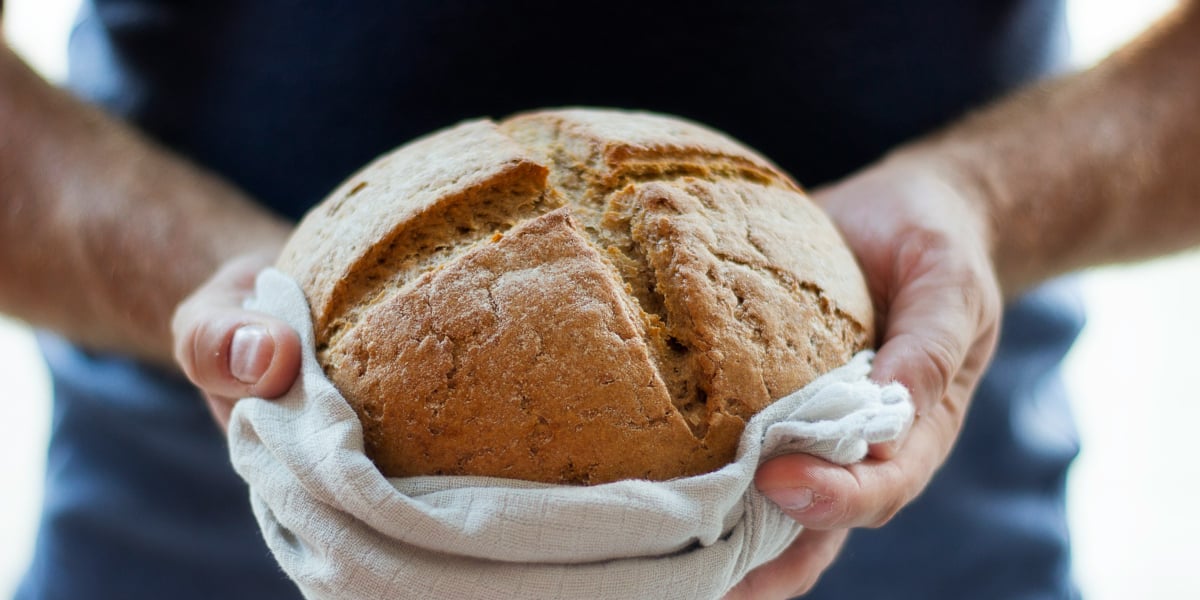Pope Leo XIV – Inaugural Mass Homily
Elected on May 8, 2025, as the 267th successor of St. Peter, Pope Leo XIV’...

This post is also available in: Spanish, Italian
The multiplication of the loaves and fishes is the only miracle of Jesus recorded in all four gospels. John calls it a sign, a symbolic event with many hidden meanings. It points beyond itself back to Old Testament persons and events and forward to the Eucharist. For the 17th Sunday in Ordinary time cycle B.
To LISTEN to this post read by Dr. Italy, click on the play arrow on the left, directly below this paragraph.
Finding hidden meanings. Unraveling mysteries. Deciphering symbols. The thrill inherent in all this is partly why Dan Brown’s book, the Da Vinci Code, sold so well.
But Brown’s secret code, the 2000 year chain of clues supposedly leading to the true identity of Jesus and his holy grail, is simply a parody of the real mystery embedded in history. The writer of this authentic “symbology” is the Holy Spirit and the code book is the Bible. For thousands of years people have “searched the Scriptures” under the guidance of the same Spirit who inspired them, looking for connections between people, places, things. They’ve discovered one coherent story of salvation history amidst many different books, written in different genres and styles, by many different human writers over the course of centuries.
Each Sunday, the Catholic Church puts together Old and New Testament scripture readings to bring out connections that many of us would fail to see without a little help. For example, just about every Christian has heard the story of the multiplication of the loaves and fishes, in fact numerous times. But we’ve probably overlooked the fact that they were barley loaves. What significance could that have?
Plenty. First of all, someone in the Old Testament had multiplied loaves, and they too were barley loaves. Elisha was the successor of Elijah, the greatest of all the prophets.
Elijah had multiplied flour and oil to save a widow and her son from starvation. Elisha did a bit better than his master, multiplying 20 barley loaves so as to feed 100, with some even left over. But in the Gospel, Jesus multiplies 5 barley loaves and feeds 5,000, leaving 12 baskets left over. We’re talking serious one-upmanship here!
So here’s one clear message: Jesus is a prophet greater than even Elijah and Elisha.
For more on this topic, consider listening to Dr. Italy’s podcast on the multiplication of loaves and fishes.
But there is someone else who is referenced here, though you have to look a bit harder to see him. Did anyone else in the Old Testament provide bread for God’s people in the wilderness? Of course! Moses and the manna. What is the symbolic number associated with Moses? There are five books of Moses which are called the Torah or Pentateuch. No wonder Jesus starts with five barley loaves. He is transforming the Mosaic Law into something much bigger, greater, and more nourishing. Moses predicted that God would raise up a prophet like himself (Deuteronomy 18:18). The people got the point–Jesus had to slip away to avoid them making him king (John 6:14-15).

But let’s get back to those barley loaves. There is even more symbolism here to probe. Barley is the first grain to be harvested in the Spring, and the feast of unleavened bread celebrates the first fruits of the barley harvest. Jesus performs this miracle as Passover approaches, and will go on later in John 6 to explain that he himself is the bread of life.
The miracle of the loaves points backwards to great events in the Old Testament to give us clues as to who Jesus really is. But it also points forward to the future, to what Jesus will do in the upper room on the night before he died, and will make present again in every Eucharist. The people recline where there is much grass, verdant pastures (Psalm 23), and the Good Shepherd, after giving thanks (eucharistia in biblical Greek), feeds them with rich fare that causes their cup to run over with blessings of not only earthly satisfaction, but eternal life.
(to learn about the beautiful site of the muliplication of the loaves and fishes, listen to Dr. Italy’s podcast on Tabgha)
How many baskets of scraps are left over? Twelve, the mystical number symbolizing God’s people. Twelve tribes, twelve patriarchs, and now twelve apostles, the patriarchs of the New Israel gathering up the remnants of a feast that will be the new covenant meal of God’s new people, the celebration of their deliverance, the new food for the journey to the true promised land, heaven.
But how about the fish? What do they symbolize? You’ll have to do some research and figure that one out for yourself!
To read more about the eucharist, see the Eucharist Library of the Crossroads Initiative.
This post on the multiplication of the loaves and fishes unpacks the mystery and symbolism of this miracle of Jesus and shows its connection to the Eucharist. It is a reflection upon the readings for the seventeenth (17th) Sunday in Ordinary Time, liturgical cycle B–2 Kings 4:42-44; Psalm 145; Ephesians 4:1-6; John 6:1-15.
Banner/featured image by an unknown artist. Public domain.
dallastexasviewer
Posted at 16:27h, 29 AprilKipper Snacks (fish) are actually Purification Snacks if you use the word Kipper as a Hebrew verb. Yom Kippur (Day of Atonement), a noun, is derived from the Hebrew word Kipper – a verb. Jesus may have always included fish (e.g. Kipper Snacks) in his meals feeding the 4000 and 5000, and at his last meal with his Disciples after they hauled in a big catch (153 fish at Jesus’ command to cast the net on the other side of the boat) so that these folks would be Purified. Perhaps Jesus wanted Peter (the fisherman) to be a “Kipper of Men” i.e. “Purifier of Men”? Remember, God told Moses to tell Aaron not to enter the Holy Place (Mercy Seat) without first performing the necessary purification, or else Aaron would be killed. Perhaps Jesus will return during Yom Kippur (Oct 11-12, 2016)? Perhaps the Day of Atonement (in 2016) will be the Last Day, and Jesus will present His Flock in the Holy Place in heaven where God resides so that we are not consumed (for our God is a consuming fire)? LEVITICUS chp 16 (The Day of Atonement)
1 The Lord spoke to Moses after the death of the two sons of Aaron, when they drew near before the Lord and died. 2 The Lord said to Moses:Tell your brother Aaron not to come just at any time into the sanctuary inside the curtain before the mercy seat[a] that is upon the ark, or he will die; for I appear in the cloud upon the mercy seat.[b] 3 Thus shall Aaron come into the holy place: with a young bull for a sin offering and a ram for a burnt offering. 4 He shall put on the holy linen tunic, and shall have the linen undergarments next to his body, fasten the linen sash, and wear the linen turban; these are the holy vestments. He shall bathe his body in water, and then put them on.
Deplorable Dave Keefer
Posted at 02:27h, 23 FebruaryInteresting and well written article, thank you.
Rob Ferguson
Posted at 13:15h, 03 MarchSo I’m really puzzled about why there would be fish in the story. Can someone tell me? I’m not sure the Kipper snacks answer that someone else gave is satisfactory. Maybe it is?
Dorothy HEALY
Posted at 00:23h, 27 FebruaryI believe the two fish symbolize the books of Psalms and Proverbs. Why? Because, unlike bread, fish are living things, and Psalms and Proverbs are ‘living books’. They come out of lived experience of the knowledge and wisdom of God.
John
Posted at 19:39h, 28 AugustThe fish may be symbolic of or a reference to the origins of Jesus and his ministry as written in John 1:37-49 which irelates the calling of Andrew, Peter, James, John, Philip and Nathaniel. Matthew threw a party after he joined the group. Philip brought Nathaniel, also known as Bartholomew. Thomas, a twin; James, cousin to Jesus; Simon, the zealot; Thaddaeus and Judas round out the original 12.
91 club Game
Posted at 02:02h, 11 MarchThis was such a thought-provoking read! I really appreciated how you delved into the deeper significance of the loaves and fishes beyond just a miracle. It’s fascinating to see how themes of sharing and abundance resonate throughout history. Thank you for shedding light on these hidden meanings!
Dr. Marcellino D'Ambrosio
Posted at 17:44h, 15 MarchYou are most welcome!